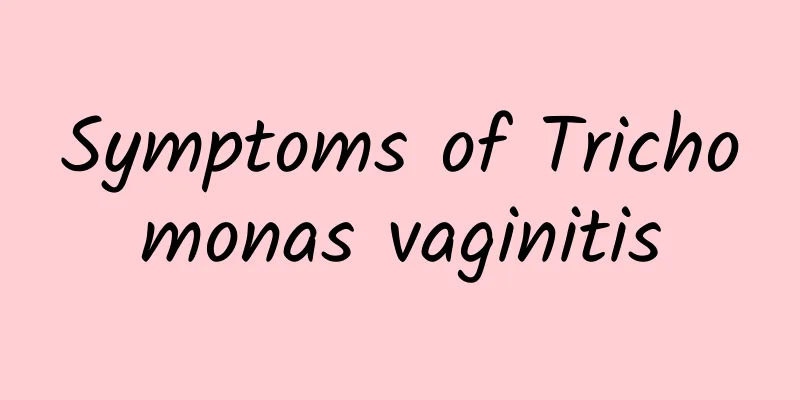Symptoms of Trichomonas vaginitis

|
Symptoms of Trichomonas vaginitis include yellow, frothy vaginal discharge with a foul odor. Now let's take a closer look at other symptoms and treatments for this disease. 1. Symptoms of Trichomonas vaginitis Common symptoms of trichomoniasis are yellowish discharge, even foamy and dirty. There is also a distinct odor. In addition, the patient may experience vaginal itching, burning sensation, and even pain or discomfort during urination. If the symptoms are severe, the vagina may also become red, swollen, and ulcerated. 2. Transmission routes of Trichomonas vaginitis This disease is mainly transmitted through sexual contact, that is, it is an external infection caused by the parasite Trichomonas. Trichomonas enters the vagina through sexual intercourse, causing inflammation and infection. Therefore, it is very important to take protective measures during sexual intercourse to reduce the risk of infection. 3. How to diagnose Trichomonas vaginitis To confirm the diagnosis of Trichomonas vaginitis, you need to go to the hospital for professional examination. Doctors usually use a microscope to examine vaginal secretions to observe whether Trichomonas is present. This method is simple and effective and can quickly produce a diagnosis. 4. Treatment of Trichomonas vaginitis After diagnosis, treatment is usually with drugs such as metronidazole or tinidazole. Your doctor may recommend applying metronidazole effervescent tablets to the vagina and taking tinidazole orally. This can more completely eliminate Trichomonas and relieve symptoms. During treatment, patients should abstain from sexual activity to prevent reinfection or transmission to their partners. 5. Recommendations for preventing Trichomonas vaginitis The key to preventing Trichomonas vaginitis is to maintain good hygiene habits and adopt safe sex. Using condoms is one of the effective ways to avoid sexually transmitted diseases. Regular gynecological examinations are also an important measure to prevent Trichomonas vaginitis. If you find any discomfort, you should seek medical attention in time to avoid worsening of the disease. 6. Precautions during treatment During treatment, patients should follow the doctor's instructions to take medication on time and not stop taking medication or change the dosage on their own. Keep the genitals clean and dry and avoid using irritating lotions. Eat more fruits and vegetables rich in vitamins to enhance the body's immunity. 7. Couple's therapy Trichomonas vaginitis is a sexually transmitted disease, so partners also need to be tested and treated to avoid mutual infection. Even if your partner has no symptoms, he or she may be carrying Trichomonas, and treatment is necessary. Through the above points, we can have a more comprehensive understanding of the symptoms, transmission routes, diagnosis methods and treatment plans of Trichomonas vaginitis. I hope this information can help everyone better prevent and treat this disease and stay healthy. |
<<: How thick is the endometrium before you get cancer?
>>: How to treat uterine fibroids and ovarian cysts
Recommend
What are the dietary taboos for those suffering from candidal vaginitis?
Now we must pay attention to our daily diet in ou...
Abnormal vaginal discharge similar to nasal discharge
Abnormal leucorrhea that is like nasal discharge ...
Parents beware! Calcium deficiency affects children's height and body shape. Doctors: Two servings of fresh milk a day help children's development
There are many benefits for children to take calc...
Different medications are used for candidal vaginitis at different stages
Generally speaking, the medication methods for ca...
What are the causes of miscarriage? There are 6 major causes
There are many reasons for female miscarriage, th...
Aerial yoga is fun! Exercise your core muscles with just a piece of cloth!
Put on casual clothes, take out your yoga mat, an...
What should you pay attention to in your diet for premature ovarian failure?
What should you pay attention to in your diet for...
Drink the right tea to slim your belly, Oolong tea can reduce abdominal fat accumulation! 4 tips for drinking oolong tea
Drinking tea has many health benefits, and drinki...
Four major hazards of cervicitis that should not be underestimated
Cervicitis is a disease that is very harmful to w...
Why is the menstrual flow heavy? Detailed explanation of the 5 major reasons for heavy menstrual flow
Women have their periods on almost fixed days eve...
What is the cause of irregular menstruation? These 4 habits can help you get rid of irregular menstruation easily
Menstruation is a woman's best friend. Almost...
What is abnormal vaginal discharge?
What is abnormal leucorrhea? 1. Abnormal leucorrh...
Liposuction is not suitable for everyone. 7 conditions to be assessed beforehand
Liposuction is a professional technique that can ...
Can I eat ginseng if I have ovarian cyst?
Can I eat ginseng if I have ovarian cyst? 1. Unde...
What is the cause of breast pain around 13 days after menstruation?
What is the cause of breast pain around 13 days a...









